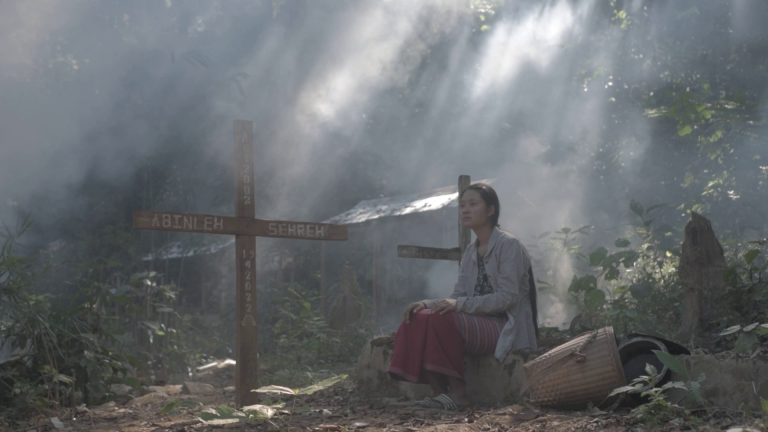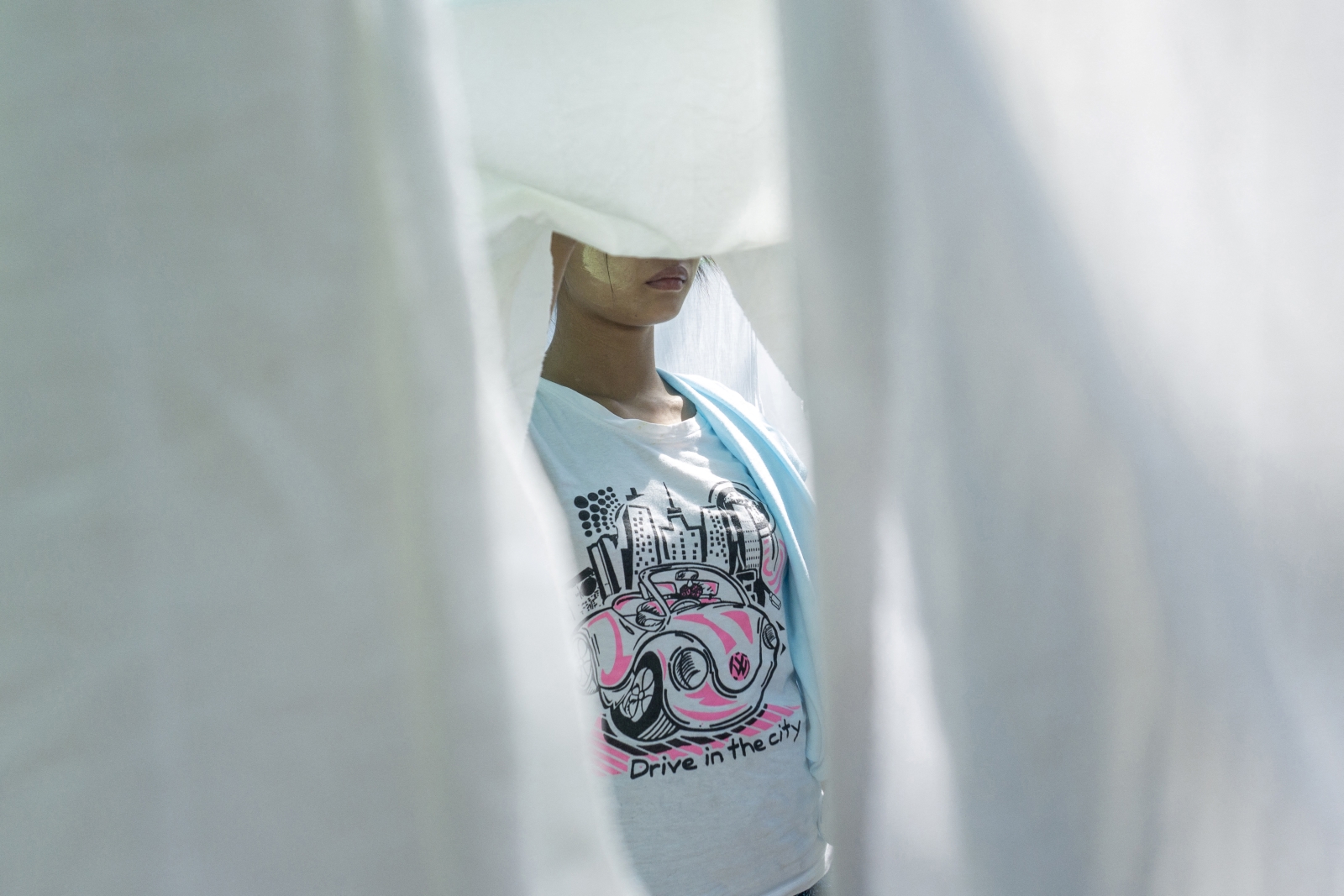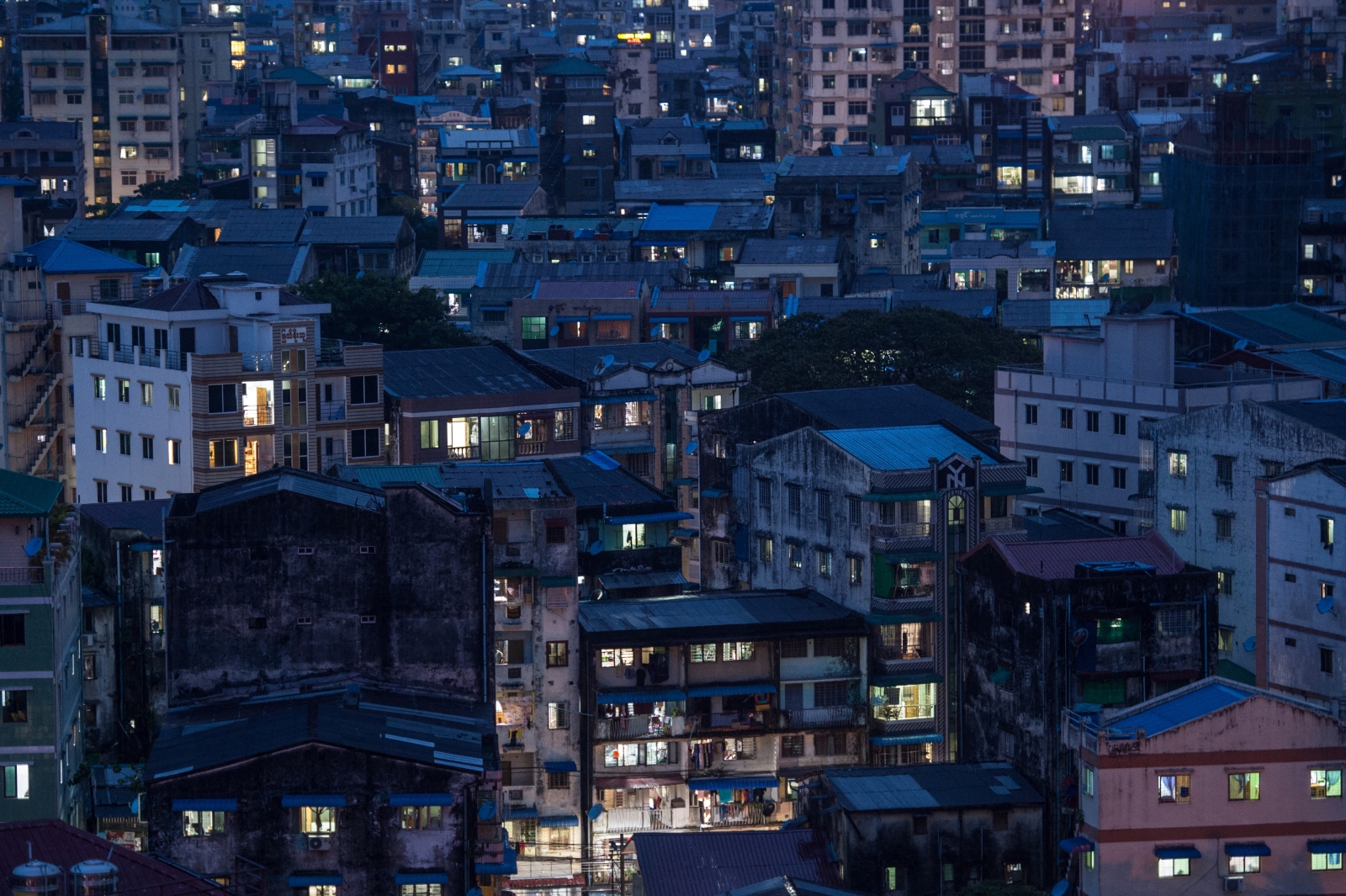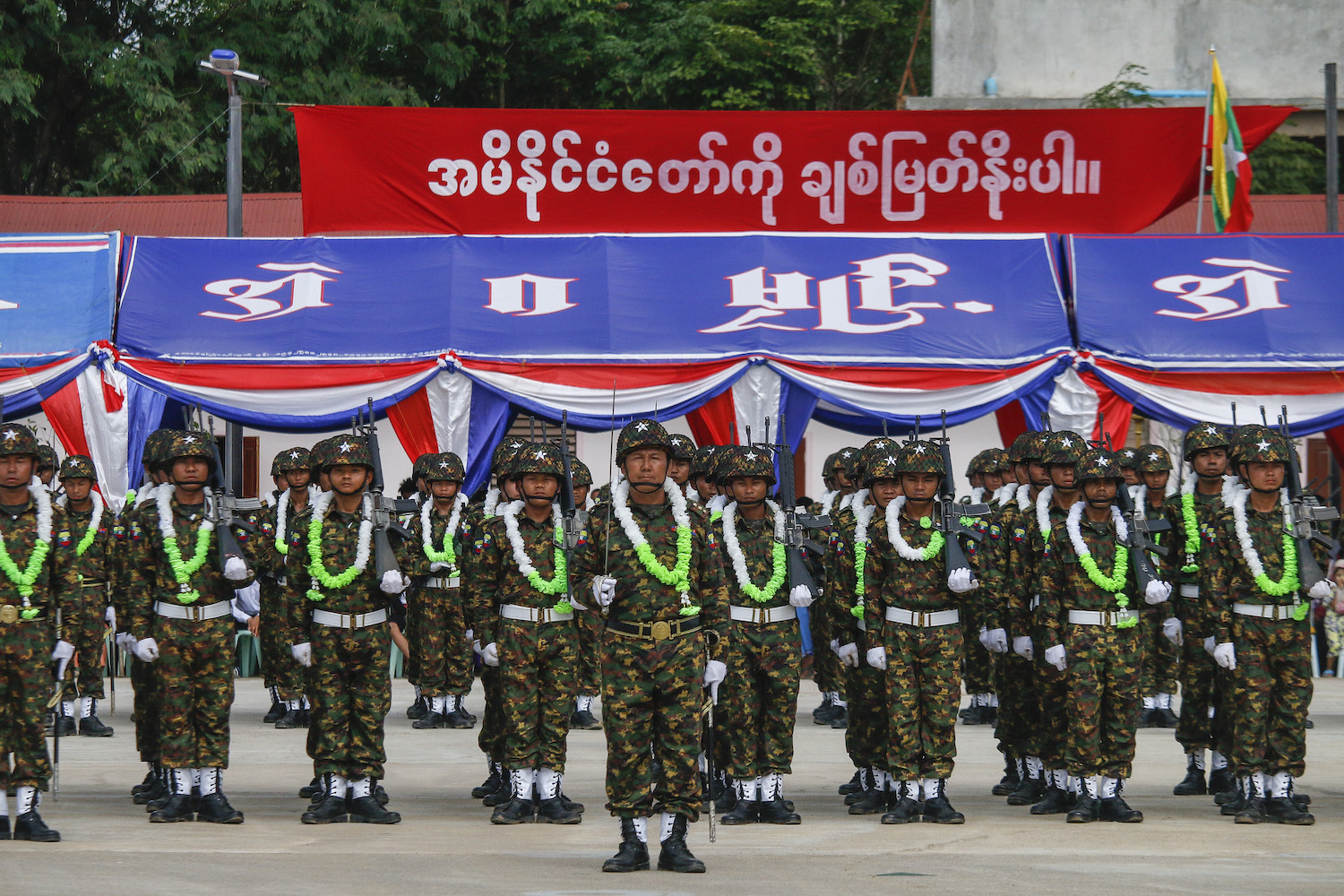OPINION
With commercialism and escapism fuelling the domestic art scene, and exhibitions abroad trying to recapture the spirit of post-coup protests, many in Myanmar are deprived of work that reflects their new reality.
By SAR PHYU | FRONTIER
While many villages in rural Myanmar are going up in flames, Yangon is hosting regular art exhibitions. The work on display in the commercial capital understandably avoids politics, due to the military junta’s intolerance of dissent. Rather than a spirit of rebellion, the boom in exhibits is largely fuelled by local collectors who, gallery owners say, are rapidly buying art both as an investment asset at a time of high inflation and as a means of escaping the bleak reality of present-day Myanmar.
Outside the country’s borders and on social media, meanwhile, dissident art continues to skewer the generals. This art draws from the initial flowering of creativity that accompanied the mass protests against the February 2021 coup, when hundreds of amateur artists channelled the collective feelings of rage and optimism in Facebook posts and on signboards.
However, this creativity risks hardening into a stale series of three-finger protest salutes and bloodthirsty military men – a repertoire that neglects the lived reality of a population that is mostly just trying to survive at a time of few jobs, rising prices, rampant crime and deteriorating public services. Yet, even in places like downtown Yangon where the regime seems to be firmly in control, a series of brave flash-mob protest-performances show a capacity to inspire people and reframe reality that recalls the ingenuity and purpose of the early post-coup art.
For the most part, though, art within Myanmar favours brisk sales and individual expression over calls to collective action. “Your next art exhibition to illustrate your passion and soul in Yangon,” reads a Facebook advert in October last year for gallery space in the luxury Strand Hotel. That same month, revered artist U Aung Myint’s latest abstract expressionist painting – drips of black paint on a white canvas – was tagged at US$20,000 at his 87th birthday solo show at the Sea Gallery.
Gallery owners in Yangon have been busy riding a wave of emerging local collectors, slotting group exhibitions of young artists between the solo shows of the well-known, while keeping a watchful eye on the new galleries popping up in smart locations across the city. And on a less commercial basis, foreign cultural centres such as the German Goethe-Institut Myanmar and French Institut français de Birmanie are helping to sustain a local arts scene with finely curated exhibitions and cultural events. “Art exhibitions are the only cultural gathering, if you don’t count nightclubs, that can keep going at this time. That’s one of the reasons we’ve seen so many of them in Yangon recently,” said a young artist who asked to remain anonymous.
“Not only are paintings selling hot these days, but they fetch much higher prices than in the past,” said Ko Htin Kyaw*, who manages a prominent gallery in Yangon, adding that a lot of the sales are made through Facebook.
Htin Kyaw explained that the uptick in the art market has been driven by turmoil elsewhere in the economy. “The steep fall of the kyat against the dollar has led people to change their money into a more stable kind of asset,” he said. “The worth of a painting tends to increase over time and you can re-sell it for more than you paid for it.”
However, Htin Kyaw stressed that art wasn’t merely being valued as an asset class, but also as a form of comfort and distraction. “The stress and trauma Myanmar people incurred from the pandemic and the coup is drawing them closer to art,” he said.
But despite their bullishness about the industry, gallery operators like Htin Kyaw are reluctant to speak about the link between politics and artistic expression. “I don’t know about it; it’s not my realm,” he said.
Ko Ye Wai*, another experienced gallery manager, was more confident in arguing that activism be kept out of art. “It looks like propaganda when we just focus on making people hate a bad person. When the junta leaders become their inspiration, most political artists in Myanmar overdo it and portray them as grotesque villains,” he said.
Yet, while it was rarely subtle, the protest art that poured over social media and onto the streets in the weeks following the coup spoke a common language that was often more hopeful than hateful. The creators of viral digital works were mostly anonymous amateurs who joined the sea of demonstrators, and helped shape the protest spirit. Their art was also directly reproduced on protest signboards, for instance when a group of 30 artists uploaded more than 100 sample posters to a website for anyone to download and print.
A common theme of these works was collective endeavour and the involvement of broad sections of society. The highlights included a series of illustrated portraits, credited simply to “Myanmar artists”, of youth from diverse backgrounds holding placards with the words, “You messed with the young generation”. Another signature work is “Our Htamein, Our Flag, Our Victory”, featuring young women waving flag poles fixed with traditional Myanmar sarongs known as longyi, or htamein when worn by women. This is a subversive gesture in a country where feminine lower garments are traditionally considered unclean.

Other works similarly sought to break taboos that, by enforcing a culture of deference and hierarchy, have enabled military rule over decades. The 27-year-old artist who calls himself Bart Was Not There, for instance, featured the Buddha and the gods of other major religions in a poster that encouraged the general strike known as the Civil Disobedience Movement.
Although the artist is far better known than most of the creators of anti-coup posters, his work at the time was informed by his role as an ordinary protester. “There were so many instances where I almost got arrested, but I got away by sheer luck,” he said.
The junta’s subsequent suppression of the protests was brutal but failed to stamp out resistance. Instead, it prompted peaceful protesters to take up arms. However, the crackdown did push the anti-coup movement underground, particularly in major cities where the military was able to assert more control. While tens of thousands have likely joined the ranks of new armed resistance groups, the millions that marched on the streets in February 2021 have largely had to resume their everyday lives, to feed themselves and their families amid an economic downturn.
The creators of many early protest works have similarly moved from directly participating in the resistance to observing or supporting it from the side-lines, while keeping a low profile in Myanmar or living in exile. Some artists have sought to represent this changed vantage point. Bart’s work, for instance, which he says “reflects where I am mentally at any moment”, now tends to focus on concepts of identity and the migrant experience in his new home overseas.
Many other artists, however, have sought to recapture the early post-coup experience. Exhibitions organised by Southeast Asia Junction in Bangkok, the Place du Palais-Royal in Paris and other overseas venues have been dominated by a series of familiar protest motifs whose power is inevitably diminishing. These include the nightly banging of pots and pans, now rare and risky outside of resistance strongholds; the once-popular protest gear of gas masks and hard hats, now gathering dust after mass urban demonstrations vanished more than two years ago; and the three-finger salute, a gesture borrowed from earlier movements in Hong Kong and Thailand.
Between these approaches and the apolitical output of Yangon art galleries, most people in Myanmar are deprived of work that honestly and critically reflects their new reality. This is a reality where most refuse to accept military rule, but where, outside of conflict zones, mass displays of dissent have largely given way to a daily struggle against steep living costs, electricity blackouts and emotional numbness.
One factor contributing to this disconnect is the need for artists-in-exile to cater to foreign appetites for “political” Myanmar art. This is a long-standing problem, but one that’s been exacerbated by the country’s renewed isolation since the coup. “Being a political artist [from Myanmar] mostly means catering to what international audiences want to see,” said an art scholar who has returned to Myanmar after studying in the United States. The scholar, who asked to remain anonymous, said this orientation determines “what issues to select and present”.
Ye Wai, the Yangon gallery owner, agreed and said exiled artists often ignored local tastes and experiences. “Throughout history, most Myanmar artists who got international experience have learned global trends from cultural exchange programmes and created something similar. They usually re-export the modified import. They rarely explore their own territory and bring something original to the world. They lose touch with their roots this way, I suppose.”
But while protest motifs risk becoming relics on the walls of faraway art galleries, creative activism on the streets of Myanmar’s cities can reforge the link between art and people’s daily struggles. On August 8 last year, on the 34th anniversary of the 1988 uprising against military rule, four youth activists from Yangon People’s Strike dressed sombrely in black and posed in several busy downtown locations while holding black umbrellas. On each umbrella, the Burmese character for eight was painted in white, so that, side-by-side, they formed “8888”, the number associated with the uprising. “This is the best performance art of the year,” said Ye Wai.
But it also demonstrated the dangers of political art in Myanmar today. A few weeks later, the regime arrested one of the four youths and a photographer who documented the performance. Pro-military social media accounts then shared a photograph of them kneeling on the ground, one of them covered in blood, next to the umbrellas that were rotated so that, instead of 8888, they spelt pe pe, the Burmese word for father.
Despite this cruel subversion of the protest, another equally bold and ingenious stunt was pulled a few months later, in November. Young members of another underground group, Yangon Revolution Force, fanned out across the city, posing separately while extending their longyis. In doing so, they revealed stirring revolutionary slogans painted on the garments, in view of hundreds of passers-by and waiting cameras. The resulting images – like those of the umbrella protesters – ripped like wildfire across social media, delighting millions at a time when, due to fear, fatigue and other factors, online engagement with politics is visibly decreasing.
The importance of artists in the fight against the junta can be easily overstated. Art by itself cannot reverse the course of a war. However, it can serve to remind the public that dissent can take many different forms, and that it remains possible even under the brutal conditions of military rule. Trying to live your life and survive these conditions does not mean that you accept them, and so long as there is creativity and minds are free, there is hope.
Sar Phyu is the pen name of a Myanmar writer living in Yangon who has covered art, film and popular culture for Frontier and other outlets
*denotes a pseudonym for security reasons







